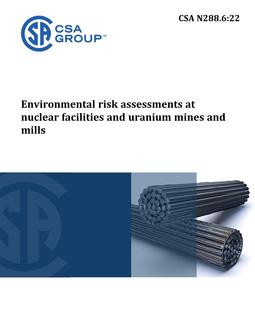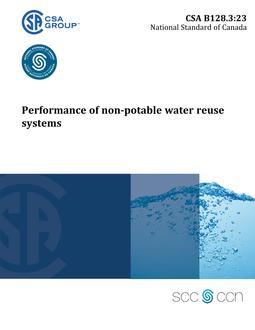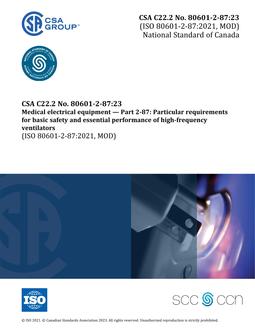
CSA N288.6:22
Preface
This is the second edition of CSA N288.6, Environmental risk assessments at nuclear facilities and uranium mines and mills. It supersedes the previous edition published in 2012. It is part of the CSA N288 series of Standards and guidelines on environmental management of nuclear facilities. The major changes in this edition include the following: a) alignment with the CSA N288 series of Standards; and b) improved guidance and clarity. The CSA N series of Standards provides an interlinked set of requirements for the management of nuclear facilities and activities. CSA N286-12, Management system requirements for nuclear power plants, provides overall direction to management to develop and implement sound management practices and controls, while the other CSA nuclear Standards provide specific technical requirements and guidance that support the management system. This Standard, which addresses the design, implementation, and management of an environmental risk assessment program that incorporates best practices used in Canada and internationally, works in harmony with CSA N286 and does not duplicate the generic requirements of CSA N286; however, it might provide more specific direction for those requirements. Users of this Standard are reminded that additional and site-specific requirements might be specified by federal, provincial/territorial, or municipal authorities. This Standard should not be considered a replacement for the requirements contained in any a) applicable federal or provincial/territorial statute, including the Nuclear Safety and Control Act; or b) regulation, licence, or permit issued pursuant to an applicable statute.
Scope
1.1 Facilities
1.1.1 Types of facilities
1.1.1.1 This Standard addresses ERAs for Class I nuclear facilities and uranium mines and mills. These facilities include a) nuclear reactors; b) uranium mines, mills, refineries, and conversion plants; c) uranium fuel fabrication plants; d) isotope processing facilities; e) particle accelerators with a beam energy equal to or greater than 50 MeV; and f) waste management facilities. Note: In this Standard, all of these facilities are included in the term “nuclear facilities”.
1.1.1.2 Parts of this Standard might also be relevant to ERAs for other facilities such as a) Class II nuclear facilities; b) institutions operating under the authority of a Nuclear Substances and Radiation Devices licence; and c) facilities that use or store naturally occurring radioactive materials. However, in these cases, the holder of the facility licence is responsible for determining the applicability and suitability of this Standard.
1.1.2 Facility lifecycle
The nature and extent of an ERA might change during the lifecycle of the facility. This Standard addresses ERAs performed during a) site preparation, construction, and commissioning; b) operations; c) decommissioning; and d) any period of institutional control that might follow closure of the facility.
1.2 Operating conditions
The ERA process described in this Standard is applicable where human and/or non-human biota might routinely be exposed to a) low-level effluents and emissions of nuclear and hazardous substances released to the environment as a result of the normal operation (as defined in Clause 3.1) of a nuclear facility; or b) physical stressors imposed on the environment as a result of the normal operation of a nuclear facility. This Standard does not address acute or high-level exposures that can result from accidents (including spills). In these cases, the holder of the facility licence is responsible for determining the applicability of this Standard.
Note: Historical contamination, including past spills, is considered to be part of the existing environmental conditions of the site and its influence is accounted for in an ERA. However, the inclusion of a spills risk assessment in an ERA is generally not required.
1.3 Releases
This Standard applies to routine effluents and emissions, including those resulting from reasonably foreseeable upset events. This Standard also applies to periodic short-term releases, provided that the releases are controlled and associated with normal operations.
1.4 Fate and transport
An understanding of the fate and transport of contaminants in the environment is necessary for performing an ERA; however, a detailed discussion of fate and transport models is outside the scope of this Standard. The risk assessor should consult CSA N288.1 for information on these concepts. Examples of additional models are provided in Clause 6.3.7.
1.5 Contaminants and physical stressors
Contaminants and physical stressors to be included in an ERA for a nuclear facility, which are addressed in this Standard, can include one or more of the following: a) non-radioactive contaminants (e.g., toxic, corrosive, or environmentally deleterious substances); b) radioactive contaminants; and c) physical stressors (e.g., noise, heat, wildlife-vehicle/bird-structure mortalities, and intake cooling water withdrawal). Other physical stressors that are not addressed in this Standard can be included in the ERA if they are identified as important to human or ecological receptors on a site or facility-specific basis.
1.6 Receptors
This Standard applies to receptors that can be affected by contaminants and physical stressors released from a nuclear facility. Human and non-human biota (ecological receptors) are included in this Standard. VCs can occasionally include abiotic components of the environment (e.g., recreational facilities or historical sites), but these are not considered receptors for the purposes of this Standard. HHRAs generally apply to off-site receptors (members of the public). Annex H addresses Indigenous communities living near the facility if those communities rely on traditional hunting, fishing, and food gathering activities as well as ceremonial and medicinal practices. In addition, on-site non-nuclear energy workers (non-NEWs) that are not covered under the facility’s radiation protection program and health and safety program can be evaluated, as appropriate to the site and ERA objectives. NEWs are covered under the radiation protection program and health and safety program in place at the facility and therefore are not considered in this Standard.
1.7 Risk management
This Standard provides guidance on evaluating and characterizing risks to receptors resulting from exposure to contaminants released from nuclear facilities. This involves identifying, evaluating, and prioritizing risks to the environment. Outputs from the ERA process can be used as input into subsequent risk management processes; however, management decisions on acceptability or unacceptability of risk and further steps to be taken are outside the scope of this Standard. Clause 9.3 addresses the provision of recommendations to risk managers based on the results of the ERA process.
1.8 Reporting
This Standard provides guidance on reporting the results of an ERA. However, risk assessors are cautioned that the statutes, regulations, licences, and permits that govern the operation of a nuclear facility can impose reporting requirements that differ from those described in this Standard. The operator of the nuclear facility is responsible for determining the required frequency and content of reports to regulatory agencies necessary to ensure compliance with the statutes, regulations, licences, or permits that govern the operation of the nuclear facility.
1.9 Terminology
In this Standard, “shall” is used to express a requirement, i.e., a provision that the user is obliged to satisfy in order to comply with the Standard; “should” is used to express a recommendation or that which is advised but not required; and “may” is used to express an option or that which is permissible within the limits of the Standard. Notes accompanying clauses do not include requirements or alternative requirements; the purpose of a note accompanying a clause is to separate from the text explanatory or informative material. Notes to tables and figures are considered part of the table or figure and may be written as requirements. Annexes are designated normative (mandatory) or informative (non-mandatory) to define their application.
Product Details
- Edition:
- 2nd
- Published:
- 02/14/2022
- ISBN(s):
- 9781488341168
- Number of Pages:
- 158
- File Size:
- 1 file , 2 MB
- Product Code(s):
- 2429788, 2429788
- Note:
- This product is unavailable in Belarus, Russia, Ukraine


